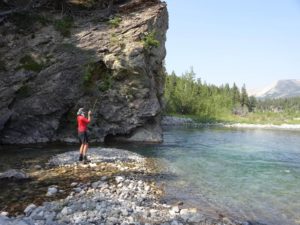 If you’ve ever experienced an uninvited guest taking up all the food and space at a gathering and making everything uncomfortable, then you’ll understand the annoyance of the situation explained in this blog post. Flathead Lake is the gathering and lake trout are the uninvited guests. The lake trout is an invasive species in Flathead Lake and it’s taking all the food and space away from native bull trout. Even worse, the lake trout attack bull trout and prey on them at their own gathering. In ecological terms, the lake trout is outcompeting the bull trout, greatly reducing the bull trout population.
If you’ve ever experienced an uninvited guest taking up all the food and space at a gathering and making everything uncomfortable, then you’ll understand the annoyance of the situation explained in this blog post. Flathead Lake is the gathering and lake trout are the uninvited guests. The lake trout is an invasive species in Flathead Lake and it’s taking all the food and space away from native bull trout. Even worse, the lake trout attack bull trout and prey on them at their own gathering. In ecological terms, the lake trout is outcompeting the bull trout, greatly reducing the bull trout population.
We headed out to Flathead Lake on a gorgeous sunny day, making the issue hit even closer to home. I feel a strong connection to bodies of water after growing up near the Chesapeake Bay in Maryland, as well as the Great Lakes later in life. It’s sad to me that the natural balance of this beautiful place is off. Seeing such unique serenity on the landscape made me want to restore that same serenity under the water. We had the opportunity that day to hear from speakers of two perspectives – cultural and ecological. Both perspectives offered up great insight on this lingering problem.
We first heard from Germaine White, an education and information specialist of the wildland recreation and natural resources department for the Confederated Salish and Kootenai Tribes (CSKT). She spoke to us next to Flathead Lake on that gorgeous day. It set the scene for some really eloquent insight on the cultural side of saving bull trout. What really resonated with me was when she said, “People were happy and content. There was abundance. Our food is our food.” By this, I believe she’s explaining the cultural relationship between people and animals. This seemed to be her main value for restoring the bull trout. Restoring food, natural balance, and health to this place is important because it’s the CSKT’s history, and their culture. It’s not just food- bull trout have intrinsic value for the CSKT.
Later that same day on Flathead Lake, we heard from Tom Bansak, a fisheries biologist at the Flathead Lake Biological Station. Like Germaine White discussed cultural implications, Tom Bansak discussed more of the lake’s ecology. He informed us that between 1890-1950, European settlers introduced 30 new species to Flathead Lake. In particular, the lake trout, white fish, and Mysis shrimp combined as an invasive trio to disturb the ecological equilibrium of Flathead Lake. The bull trout had been thought of as this major cannibalistic predator of Flathead Lake, but little did anyone know, the lake trout would eat fish as big as their own size, preying on the native species of this peaceful place. On a larger scale, aquatic invasive species like the lake trout harm the economy, environment, and recreation of the area, giving us all kinds of valuable reasons to save the bull trout.
So who’s going to kick the lake trout out of the party? According to a 2014 Environmental Impact Statement issued by the CSKT and titled “Proposed Strategies to Benefit Native Species by Reducing the Abundance of Lake Trout,” the proposed action is using a “combination of fisheries population management tools, including angling and netting”. Les Bigcrane, a wild land recreation manager for the CSKT alongside Germaine White, talked to us a bit on the same day we heard from Tom and Germaine. He informed us that the current fishing limit on lake trout is 100 per day, and some people will even catch that amount! That goes to show how abundant an aquatic invasive species can be, to what extent they can take over, and how much some members of the tribes want them gone. Les said they want to remove this limit, but for now have the best anglers helping to manage the lake. Fishing for lake trout provides a huge economic boost for the region. Montana Fish, Wildlife, and Parks supports the lake trout for economic and recreational reasons, showing the extent to which invasive species can even permeate the economy. There’s been an increase in harvest of lake trout, but there hasn’t been a decrease in population of lake trout or an increasing bull trout population to correspond. It may not be until a 50% or 75% reduction of lake trout that results will show.
This extensive issue is happening underneath the beautiful blue waters of Flathead Lake at the cost of a native species just trying to have fun at its own party. The bull trout is busy holding its own down there, so it’s up to us here on land to act on this cultural and ecological issue. No one wants to be the person to kick someone out of the party, but time is up for the lake trout. The natural balance of Flathead Lake and strong cultural roots of the CSKT need the bull trout restored.